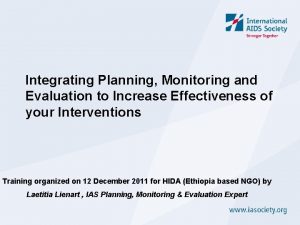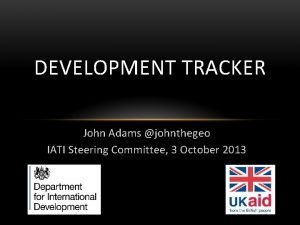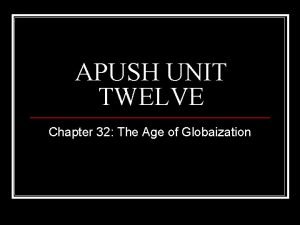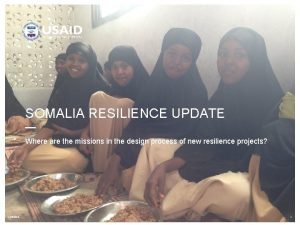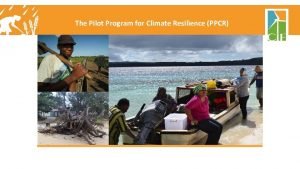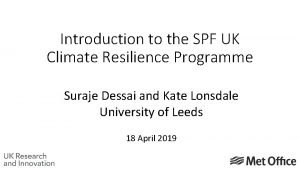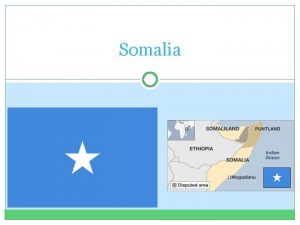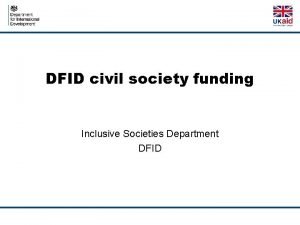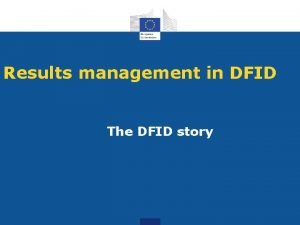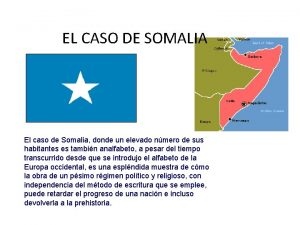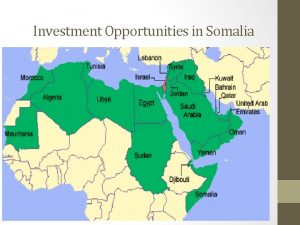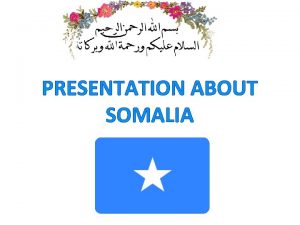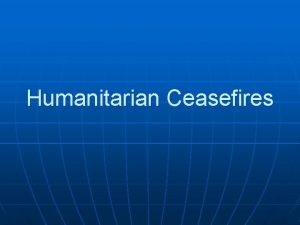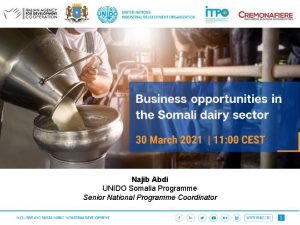DFID Somalia Humanitarian Resilience Programme Humanitarian Needs Overview










- Slides: 10

DFID Somalia Humanitarian & Resilience Programme

Humanitarian Needs Overview 2011 famine killed 260, 000 (1/2 children U 5) People in Emergency / Crisis (millions) 4 Chronic acute food insecure (average 1 m each year). Further 2 million or more in need of assistance 3. 2 Over 200, 000 children malnourished, up to 50, 000 severely 2 harvests / year (Deyr 20% / Gu 80%) – reliant on food imports. Both can be lost to climate events 2. 51 2. 1 2 1. 5 0. 9 0. 82 1 1. 05 1 Conflict caused displacement (1. 1 m IDPs / 1 m refugees in the region) Numbers growing due to Yemen, AMISOM offensive 2003 2004 2005 2006 2007 2008 2009 2010 2011 2012 2013 2014 2015

Background to IRF / Triggers Challenges. . Existing EW products were comprehensive (e. g. FSNAU 16 warning products) but decision making processes and release of funds was slow. 50% of deaths occurred before famine declared. DFID approval process slow, (Business cases, Implementing partner proposals, proposals and approvals process); information flow problematic and time consuming; access very poor (UN and NGO expulsions by AS), .

LESSONS LEARNED 2011 famine All evaluations point to need for a robust EW / EA trigger system and flexible funding DFID accepted that its country office needed predictable and assured multi year Humanitarian and Resilience funding, pre approved, with rapid decision making capability in country and a “no regrets” approach to preparedness funding. Result 2013. Design and approval of 4 year Humanitarian BC. £ 145 million over 4 years. Includes a balance of long term resilience building inputs, and shorter term emergency and life saving inputs (IRF) using mostly the same IPs, with duel role. Since 2013 DFID pushed for HCT level sector wide EW/EW Triggers system, now being established by FAO / OCHA.

2013 -2017 Programme £ 145 million (US$ 218 million) UN Resilience programme (£ 24 m) Emergency Aid Resilience NGO Resilience programme – BRCi. S (£ 21 m) NGO Nutrition programme – SNS (£ 10 m) IRF £ 40 m Better M&E / learning UNHCR – Refugee and IDP returns (£ 3 m) Influence the system International Committee of the Red Cross (£ 14 m) UN Managed Common Humanitarian Fund (£ 26 m) Aid Enablers (OCHA/UNHAS/FSNAU) (£ 5 m)

Resilience programme flexibility • Resilience programmes include an element of short term flexible funding for immediate use. E. g. BRCi. S programme has approx. £ 2. 5 million, or 12% of total budget available. • Further short term funds DFID IRF, is held in country office for rapid release • E. g. El Nino prep work by NGO consortium, initially funded from within Resilience flexi funds, followed up by DFID IRF funds.

INTERNAL RISK FACILITY (IRF) £ 10 million per year, (£ 15 this year) within Multi Year Humanitarian programme. IRF projects designed to meet short term needs, e. g. displacement, short term food insecurity, flood prevention in face of El Nino etc. IRF proposals explicitly linked to EW indicators and EA Triggers system, This system was motivated by DFID, now being implemented by OCHA / FAO. All projects are designed around Triggers. IRF projects are implemented by • UN partners (WFP, UNICEF, FAO) • NGO consortia BRCi. S and SNS) Typical UN IRF grant £ 3 million for 6 months NGO IRF grant is currently £ 7 million for whole of 2015 comprising 14 + humanitarian projects. Disbursement processes: Either by existing AG with NGO consortium or by individual IRF Mo. U with UN agencies.

EW/EA Triggers. Key Indicators Table 1. List of Key Indicators Selected Key Indicator Set Specific Indicators 1. Climate Rainfall Normalized Difference Vegetation Index (NDVI) Tropical storm alerts El Nino/La Nina Outlook Price of water 2. Population Movement Number of displaced population 3. Nutrition Trends in admission to feeding and MCH Centres Trends in acute malnutrition from health facilities Trends in acute watery diarrhoea (AWD) 4. Health Measles outbreak Acute Watery Diarrhoea (AWD) outbreak Polio outbreak 5. Market Maize prices Sorghum prices Local goat prices Wage labour Terms of trade (wage labour to cereals) Terms of trade (local quality goat to cereals)

Decision making for Early Action

Questions to you… Is Multi Year funding necessary for a no regrets approach? What level of decision making should a country office have? How important is it that major donors agree on emergency funding mechanisms?
 Dfid logframe template
Dfid logframe template Dfid development tracker
Dfid development tracker Globalization apush
Globalization apush Somalia natural resources
Somalia natural resources Humanitarian programme cycle
Humanitarian programme cycle Pilot programme for climate resilience
Pilot programme for climate resilience Uk climate resilience programme
Uk climate resilience programme Ntep organogram
Ntep organogram Primary needs and secondary needs
Primary needs and secondary needs Strategic gender needs and practical gender needs
Strategic gender needs and practical gender needs Primary needs and secondary needs
Primary needs and secondary needs
